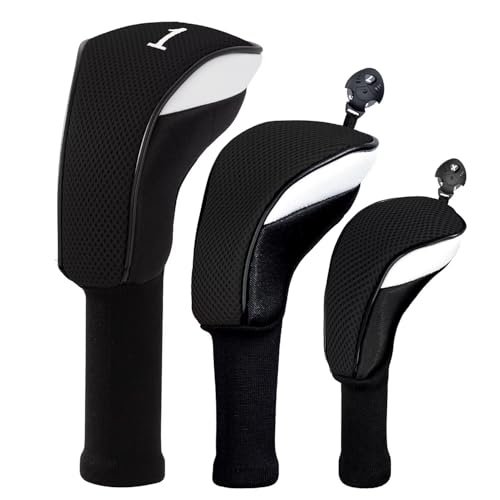Golf shafts are an essential component of golf clubs, and they play a crucial role in determining the performance of the club. The right shaft can help you hit the ball farther, straighter, and with more accuracy. However, choosing the right golf shaft can be an overwhelming task, especially for beginners. This is where golf shaft comparison charts come in handy.


A golf shaft comparison chart is a tool that allows you to compare different golf shafts based on various factors such as material, flex, weight, and launch angle. Armed with this information, you can make an informed decision about which golf shaft is best for you. The chart can also help you understand the key differences between various shafts and how they influence the performance of your golf club.
Key Takeaways
- Golf shaft comparison charts can help you understand the key differences between various golf shafts and how they influence the performance of your golf club.
- Factors such as material, flex, weight, and launch angle are important considerations when choosing a golf shaft.
- By using a golf shaft comparison chart, you can make an informed decision about which golf shaft is best for you.
Understanding Golf Shafts
https://www.youtube.com/watch?v=60ZXsrKDoVQ&embed=true
When it comes to golf clubs, the shaft is one of the most important components. It connects the clubhead to the grip, and it plays a crucial role in determining how the club performs. Understanding the different aspects of golf shafts can help you make better decisions when it comes to selecting the right club for your game.
Shaft Flex
One of the most important aspects of a golf shaft is its flex. This refers to how much the shaft bends during the swing. The most common flex options are stiff, regular, and flexible. Stiff shafts are best suited for golfers with faster swing speeds, while flexible shafts are better for golfers with slower swing speeds. If you’re not sure which flex is right for you, try out different options to see which one feels most comfortable.
Shaft Weight
Shaft weight is another important factor to consider. Lighter shafts can help you swing the club faster, while heavier shafts can give you more control over your shots. The most important thing is to find a shaft weight that feels comfortable and allows you to swing the club smoothly.
Shaft Length
The length of the shaft can also have a big impact on your swing. Longer shafts can help you generate more clubhead speed, while shorter shafts can give you more control over your shots. The optimal length for your shaft will depend on your height, swing style, and personal preferences.
Shaft Profile
The profile of the shaft refers to its shape and how it tapers from the butt section to the tip. Different shaft profiles can affect how the club feels during the swing and how it performs. For example, a shaft with a softer tip can help you get more height on your shots, while a stiffer tip can help you hit the ball lower.
In conclusion, understanding the different aspects of golf shafts can help you select the right club for your game. Shaft flex, weight, length, and profile are all important factors to consider when making your decision. Don’t be afraid to try out different options to see what works best for you.
Factors Influencing Shaft Performance
https://www.youtube.com/watch?v=nPTcnxYPK9A&embed=true
When it comes to golf shafts, there are several factors that can influence their performance. Understanding these factors can help you make an informed decision when selecting a golf club. Here are some of the key factors that you should consider:
Weight
The weight of a golf shaft can have a significant impact on your swing and the distance you are able to achieve. Generally, lighter shafts can help you achieve faster swing speeds, which can lead to greater distance. However, heavier shafts can provide greater control and stability, which can be beneficial for some golfers.
Flex
The flex of a golf shaft refers to how much it bends during the swing. This can affect the trajectory and spin of the ball, as well as the feel of the club. Golf shafts typically come in several different flex options, including regular, stiff, and extra stiff. Choosing the right flex can help you achieve greater distance and accuracy.
Torque
Torque refers to the degree to which a golf shaft twists during the swing. Higher torque can provide greater feel and control, while lower torque can help you achieve greater distance. However, it is important to find a balance between torque and other factors, such as weight and flex.
Length
The length of a golf shaft can also impact your swing and the distance you are able to achieve. Longer shafts can help you achieve greater distance, but can also make it more difficult to control the club. Shorter shafts can provide greater control, but may result in shorter shots.
Materials
Golf shafts can be made from a variety of materials, including graphite, steel, and titanium. Each material has its own unique characteristics, and can impact the performance of the club in different ways. Graphite shafts are typically lighter and can help you achieve faster swing speeds, while steel shafts are typically heavier and can provide greater control and stability. Titanium shafts are a relatively new option, and are known for their durability and strength.
Overall, when selecting a golf shaft, it is important to consider a range of factors, including weight, flex, torque, length, and materials. By understanding these factors and how they impact performance, you can choose a golf club that is well-suited to your needs and playing style.
Types of Golf Shafts

When it comes to golf shafts, there are two main types: steel and graphite. Steel shafts are heavier and offer more control, making them a popular choice for irons. Graphite shafts, on the other hand, are lighter and allow for more distance, making them a popular choice for woods.

Driver Shafts
When it comes to driver shafts, there are a few different options to consider. The flex of the shaft is an important factor to consider when selecting a driver shaft. A shaft that is too stiff or too flexible can negatively impact your game. It’s essential to get fitted for the correct driver shaft to ensure optimal performance on the course.
Iron Shafts
Iron shafts come in a variety of different flexes, including regular, stiff, and extra stiff. The flex of the shaft will depend on your swing speed and overall strength as a player. It’s important to get fitted for the correct iron shafts to ensure that you are getting the most out of your golf clubs.
Fitting
Getting fitted for the correct golf shafts is essential to ensure optimal performance on the course. A golf shaft comparison chart can be a useful tool to help you understand the different options available and make an informed decision.
Golf Clubs
When selecting golf clubs, it’s important to consider the type of golf shaft that is best suited for your game. The right golf shaft can make a significant difference in your performance on the course.
Tee
The type of golf shaft you select can also impact your tee shots. A graphite shaft can provide more distance off the tee, while a steel shaft can offer more control. It’s important to select the right type of golf shaft for your tee shots to ensure that you are getting the most out of your game.

Overall, selecting the right golf shaft is essential to ensure optimal performance on the course. Take the time to consider your swing speed, strength, and overall game when selecting golf shafts. A golf shaft comparison chart can be a useful tool to help you make an informed decision.
Leading Shaft Manufacturers and Their Offerings

When it comes to golf shafts, there are a lot of manufacturers to choose from. Some of the leading manufacturers in the industry include Mitsubishi, Aldila, and Accra. Each of these manufacturers offers a variety of shafts that cater to different types of golfers.
Mitsubishi is known for their high-quality shafts that provide a great feel for golfers. Their Diamana and Tensei Pro shafts are two of their most popular offerings. The Diamana shafts are designed to provide a smooth feel and consistent performance, while the Tensei Pro shafts are designed to provide a more stable feel and increased distance.
Aldila is another popular manufacturer of golf shafts. Their Tour Green and Tour Blue shafts are two of their most popular offerings. The Tour Green shafts are designed to provide a low launch and low spin, while the Tour Blue shafts are designed to provide a mid launch and mid spin.

Accra is a relatively new player in the golf shaft industry, but they have quickly made a name for themselves by producing high-quality shafts that cater to the needs of golfers. Their Fx and DyMatch lines of shafts are designed to provide customization and performance to a new level. The Accra FX 2.0 200 Series 260 shaft is perfect for players looking for a medium spin and medium launch rate.
Overall, there are many different shaft manufacturers to choose from, each with their own unique offerings. When choosing a shaft, it is important to consider your own needs and preferences, as well as the recommendations of your golf pro.
The Role of Club Fitters

When it comes to optimizing your golf club performance, club fitters are an invaluable resource. These professionals have the expertise and tools to help you select the right golf shaft for your game, based on your unique swing characteristics and preferences.
One of the key benefits of working with a club fitter is that they can take precise measurements of your swing speed, tempo, and release point, among other factors. Armed with this information, they can recommend the best golf shaft flex, weight, and launch angle for your needs.
In addition to helping you select the right golf shaft, club fitters can also customize your club to your exact specifications. This might include adjusting the lie angle, loft, and grip size, among other factors. By customizing your club to your unique swing, you can achieve optimal performance on the course.
Overall, working with a club fitter can help you get the most out of your golf club investment. Whether you’re a beginner or a seasoned pro, a club fitter can help you find the perfect golf shaft for your game.
Analyzing Shaft Comparison Charts

When you’re in the market for new golf clubs, one of the most important factors to consider is the shaft. With so many options available, it can be overwhelming to choose the right one. This is where a golf shaft comparison chart comes in handy. A comparison chart allows you to see the differences between various shafts based on their specifications, such as material, flex, weight, and launch angle.
One of the main benefits of using a comparison chart is that it can help you improve your score. By selecting the right shaft, you can improve your shot dispersion and reduce your slice or hook. A comparison chart can also help you find a shaft that matches your swing speed and stiffness preference, which can lead to more consistent shots and better ball flight.

Another important factor to consider when analyzing a comparison chart is the price. While it’s tempting to go for the most expensive option, it’s not always necessary. In fact, there are many affordable options that can perform just as well as their more expensive counterparts. By using a comparison chart, you can find a shaft that fits your budget without sacrificing performance.
When analyzing a comparison chart, it’s important to pay attention to the specifications of each shaft. For example, the CPM (cycles per minute) rating can give you an idea of the stiffness of the shaft. A higher CPM rating indicates a stiffer shaft, while a lower rating indicates a more flexible shaft. This can be important for players who prefer a certain level of stiffness in their shafts.
In addition to the CPM rating, you should also pay attention to the stiffness profile of each shaft. Some shafts have a consistent stiffness from the butt to the tip, while others have a varying stiffness profile. Understanding the stiffness profile can help you select a shaft that matches your swing style and delivers the desired ball flight.
Overall, a golf shaft comparison chart is a valuable tool for any golfer looking to improve their game. By analyzing the specifications, MPF (shaft fitting system), and price of each shaft, you can find the perfect option that matches your swing style and budget.
Frequently Asked Questions


What factors should I consider when choosing a golf shaft?
When choosing a golf shaft, there are several factors to consider, including the weight, flex, torque, and length of the shaft. The weight of the shaft affects the performance and feel of the club, with lighter shafts generally made from graphite and heavier shafts made from steel. The flex of the shaft determines how much the shaft bends during the swing, and it is important to choose a flex that matches your swing speed and tempo. The torque of the shaft measures how much it twists during the swing, and a lower torque can help reduce unwanted spin. Finally, the length of the shaft can affect the swing speed and accuracy of the shot.
How do I compare different golf shafts?
To compare different golf shafts, you should consider the factors mentioned above and how they match your swing. You can also look at the specifications of each shaft, including the weight, flex, torque, and length, and compare them to your current shaft or other options. Additionally, you can try out different shafts on the driving range or during a fitting session to see how they perform and feel.
What are the benefits of using a lighter shaft for my driver?
Using a lighter shaft for your driver can provide several benefits, including increased swing speed, improved distance, and better control. Lighter shafts are generally easier to swing, which can lead to a faster swing speed and more power. Additionally, a lighter shaft can help you achieve a more consistent swing and hit the ball more accurately.
Is there a recommended weight for a driver shaft?
There is no one-size-fits-all answer to this question, as the recommended weight for a driver shaft depends on your swing and personal preferences. However, most golfers tend to use driver shafts that weigh between 50 and 70 grams, with some using lighter or heavier options depending on their swing speed and tempo.
Are there any apps or tools to help me select the right golf shaft?
Yes, there are several apps and tools available to help you select the right golf shaft for your swing. Some popular options include the Titleist SureFit® Performance Guide, the Ping nFlight Fitting App, and the TaylorMade MyRoundPro app. These tools use data and analytics to recommend the best shaft options based on your swing characteristics and performance.

What are the differences between steel and graphite golf shafts?
Steel and graphite golf shafts have several differences, including weight, flex, and feel. Steel shafts are generally heavier and stiffer than graphite shafts, which can provide more control and accuracy for some golfers. Graphite shafts, on the other hand, are generally lighter and more flexible, which can lead to increased swing speed and distance for some golfers. Additionally, graphite shafts can provide a softer feel and reduce vibrations during the swing.










